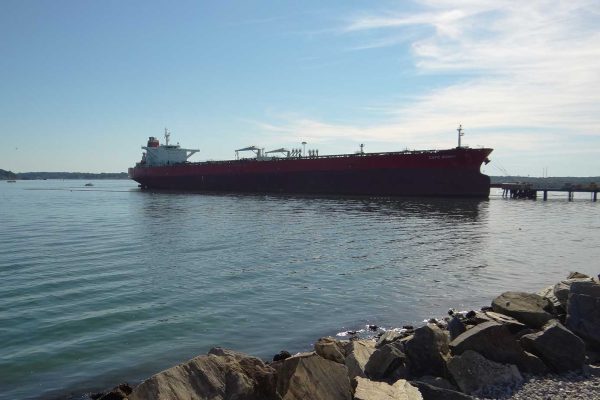I’ve known for a long time that Maine is reliant on heating oil and has heavy emissions from the transportation sector. However, without fossil fuel infrastructure such as oil rigs or fracking wells in Maine, it’s easy to forget just how reliant we are. We import all our fuel, mostly via tanker ships and pipelines. This summer, I wanted to investigate what the fossil fuel import scene for Maine looks like. Where do we get our natural gas? Oil imports? At what points do these enter the state, and in what quantities?

Oil tanker in Casco Bay (BComeau/NRCM)
This question is particularly relevant now for a few reasons. For one, ship strikes can harm marine mammals, including accounting for a significant proportion of whale deaths.¹ Second, Maine is at a critical point in its plan to develop offshore wind in the Gulf of Maine. It is important that we better understand what this means for our current energy infrastructure. Maine’s plans call for procuring three gigawatts of energy from floating offshore wind turbines rather than fossil fuels, with significant economic, energy, and climate benefits. But what might this mean for fossil fuel transport in the Gulf of Maine? The first step in my research was to start with publicly available data and see where I ended up. The Energy Information Administration, which collects a wealth of national energy data for independent analysis, publishes national import level data for both natural gas and petroleum products. As it turns out, much of the data I was looking for — ship-level statistics — is hard to come by and isn’t published. I ended up getting my shipment-level data from the environmental protection programs of Maine and Massachusetts.
Another important consideration was that while national boundaries affect which government will store and regulate data, the divide between Maine and New Brunswick is ecologically arbitrary. The Gulf of Maine encompasses everywhere from Cape Cod to the Bay of Fundy, or in other words, cities from Boston, Massachusetts, to Saint John, New Brunswick. I would need to collect data from both countries to be able to paint a full picture of what fossil fuel shipping in the Gulf of Maine looks like. Maine collects data from fossil fuel companies like Irving, Gulf, Global, and Sprague, who operate fuel import terminals throughout the state, including ship names, contents, dates, and fuel amounts. In 2023, about 60 different tankers delivered some amount of fuel to Maine ports.
With this data, you can chart a map of what tanker voyages look like in Maine. In 2023, there was a tanker unloading fuel to a Maine port two out of every three days, with the majority being vehicle and heating fuel. Maine’s ports are in Bucksport, Searsport, and Portland, although Portland receives the most ships, along with all shipments of crude oil. In 2023, Maine imported 34 million barrels of fuel, enough to fill about 100 tankers.

Oil tanker near Bug Light in South Portland
For instance, let’s look at a standard oil and chemical tanker, the Nor’easter. This is a small coastal tanker, measuring 184 meters (about twice the length of a football field) long and 27 meters wide. While it flies a Marshall Islands flag, which is common for commercial vessels, it spends a considerable amount of time in the Gulf of Maine (as its name suggests). It usually carries a mix of diesel, gasoline, jet fuel, and #2 oil (heating oil), discharging several products at a given port. It might work its way up the Maine coast in a few days to a week, delivering hundreds of thousands of barrels of fuel to several companies in a single trip. All told, in 2023, it made dozens of trips through Maine, bringing in more than 5.5 million barrels of fuel. In fact, as I write this in early August, the Nor’easter is docked at the Saint John Refinery Terminal, having just returned from a Portland delivery.
Methane gas, sometimes known as natural gas, is a bit of a different story. Since it is so flammable, and because it is transported in liquid form (liquified natural gas, or LNG) at supercooled temperatures, LNG ports tend not to be in cities. Maine has no LNG terminals, instead sourcing gas via pipelines from other terminals in New Brunswick and Massachusetts, which imported a combined 34.3 billion cubic feet of natural gas in 2022. Natural gas shipments still pass through the Gulf of Maine, though. The terminal in Saint John, for example, is permitted to receive 120 ships a year, and the Everett LNG terminal in Massachusetts receives even more, with twice the imports in 2022. In 2023, Maine consumed almost 59 billion cubic feet of natural gas, enough to fill 20 LNG tankers.
I should also note that the amount of imports Maine receives via rail and truck, and the amount of fossil fuel transport needed after fuels arrive on a tanker, is substantial. It takes lots of energy to move these heavy products through every step of the transportation process. Once that heating oil reaches your home, it may have had to take several boats, a train, and a truck on a trip lasting weeks or even longer, causing emissions of its own along the way. And every time it’s transferred, it risks spilling or leaking, which would be catastrophic to the environment. Maine has experienced catastrophic oil spills before, like the Julie N in 1996 or the Northern Gulf in 1963, and we’ve had hundreds of small spills, too.
A major takeaway from this project was just how inaccessible the data was; finding the numbers took up a huge amount of time. Because of this, the scale of the industry, even in Maine, is out of sight and mind for most people. Having seen the amount of fuel that’s transported through the Gulf of Maine, it seems more important than ever to me that we develop offshore wind in Maine to reduce our fossil fuel use. We have the chance to avoid the risk of future oil spills, ship strikes to animals, and the emissions produced by both the use and transportation of these fuels. It seems like a clear choice to me.

—Brynne Robbins, NRCM 2024 Summer Advocacy Intern











Leave a Reply